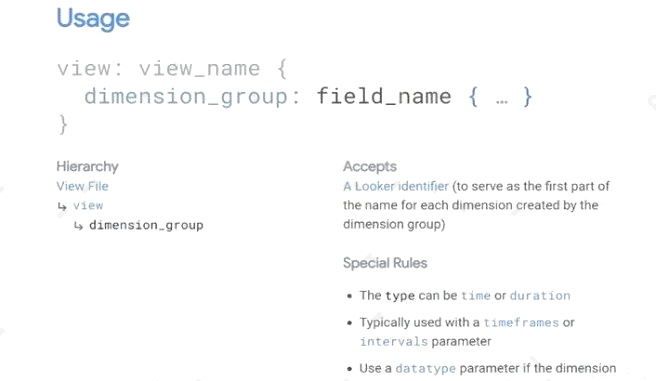google google lookml developer practice test
Google LookML Developer
Last exam update: Jul 20 ,2024
Question 1
A developer has created a persistent derived table that tracks new or updated orders and they want to cache the results. The
cache should be refreshed whenever some new order is available on the underlying datasource table my tablename or at
least every 24 hours.
Which datagroup definition will refresh the cache as expected?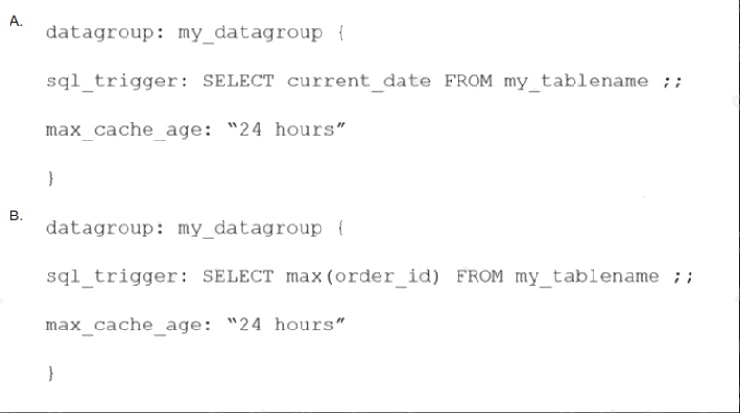
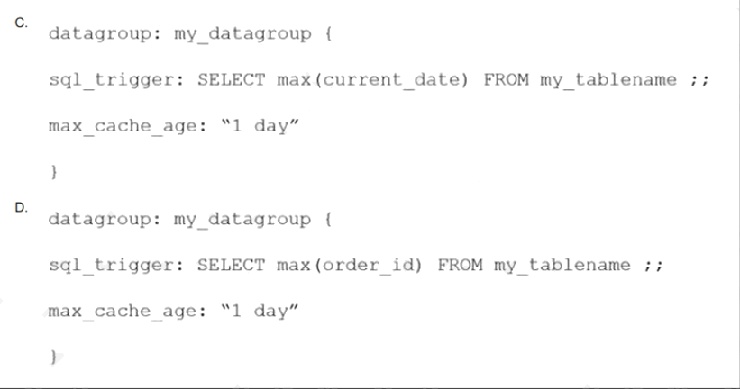
- A. Option A
- B. Option B
- C. Option C
- D. Option D
Answer:
A
Question 2
A user reports that, when a date dimension is filtered to before now results are returned that consistently include tomorrow.
Dimension fill has been ruled out as a cause of the issue.
Which LookML parameter should be used to resolve this issue?
- A. Week_start_day
- B. Convert_tz
- C. Datatype
- D. Fiscal_month_offset
Answer:
D
Question 3
The developer has moved the orders Explore (shown below) from model_a to model_b, where both models are in the same
project, and all users have access to both models.
Connection: demo
include: .view explore: orders {}
What will happen after making this change?
- A. Dashboard tiles and Looks will be automatically pointed to the orders Explore in model_b.
- B. Dashboard tiles and Looks will redirect to the new database connection.
- C. Dashboard tiles and Looks that rely on this Explore will be deleted.
- D. Dashboard tiles and Looks that rely on this Explore will return an error.
Answer:
C
Question 4
Users viewing an Explore should be able to view rows of data only where the value of the product.brand column matches the
value of the users company user attribute.
Which access filter should the developer use to meet this requirement?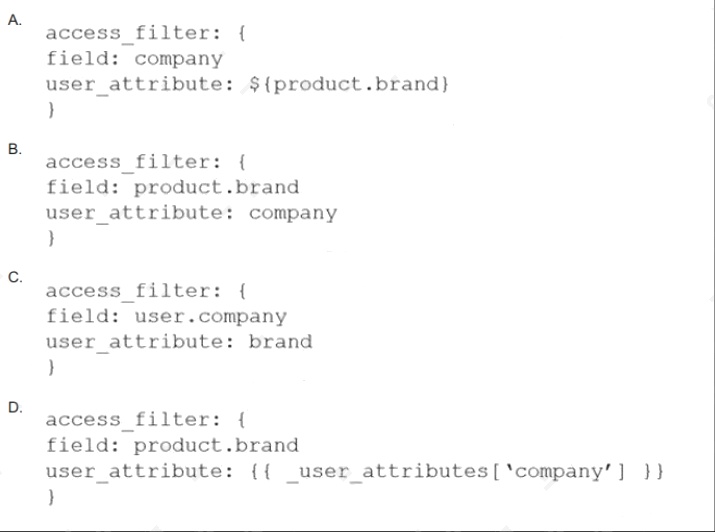
- A. Option A
- B. Option B
- C. Option C
- D. Option D
Answer:
B
Question 5
A developer is defining the users table within a view file in Looker. The users table will be available as an individual Explore
and it will also be joined into other Explores, such as the products Explore. The developer needs to limit the fields visible in
the products Explore without affecting the visibility of the fields in the users Explore.
How should the developer meet this requirement?
- A. Use the fields parameter at the join level for the products Explore to specify which fields should be included and leave the users Explore as is.
- B. Create duplicate dimensions and measures, one for the users Explore and one for the products Explore, and use the hidden parameter to modify the visibility of the fields.
- C. Create two view files for the users table. One view file will have all possible fields for the users Explore, and the other will have only the fields required for the products Explore.
- D. Use the hidden parameter in the users view file for the fields that should not come over to the products Explore and leave the users Explore as is.
Answer:
A
Question 6
A developer wants to create a measure that shows the item count broken out by category. When a second, more granular
dimension is added to the same query, the count broken out by category should still represent the original aggregation and
be duplicated on each line. The business wants this count in category available in the Explore section without any
additional work done by the end user. For example:
The Count column represents the count for each combination of Category and Item. The Count in Category column

represents the count for each Category only.
How can the developer address this need with a LookML object?
- A. Create a measure filtered on Category, and make the filter value controlled by a parameter.
- B. Calculate the measure using a derived table, and then join that derived table back into the Explore.
- C. Create a measure with type: sum_over_dimension, and make the dimension value controlled by a parameter.
- D. Calculate the overall count using table calculations in the Explore.
Answer:
B
Question 7
A LookML developer builds a view that contains sensitive information. Only members of the Management group should have
access to the view. The developer needs to restrict the view from appearing in the field picker for any Explore where it might
be joined for users outside of the Management group.
Which LookML parameter should the developer use to meet this requirement?
- A. access_grant
- B. always_filter
- C. access_filter
- D. sql_always_where
Answer:
A
Explanation:
Reference: https://docs.looker.com/admin-options/tutorials/permissions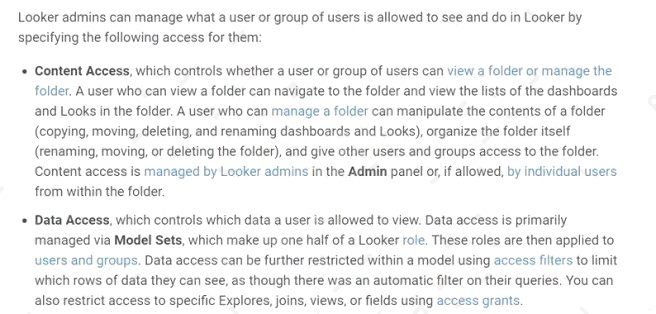
Question 8
A developer commits changes after adding LookML for a new measure. Upon pulling from production, the developer notices
the following lines in the LookML: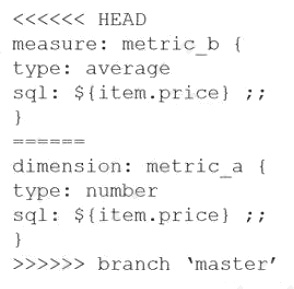
- A. Remove “<<<<<< HEAD”, “======”, and “>>>>>> branch ‘master’”
- B. Remove “<<<<<< HEAD”, “======”, and everything following “======”
- C. Remove everything between “<<<<<< HEAD” and “======”, and “>>>>>> branch ‘master’”
- D. Remove everything between “<<<<<< HEAD” and “>>>>>> branch ‘master’”
Answer:
D
Question 9
Users must be able to click on the Country field in their Explore and be redirected to another Explore that shows all countries
compared.
Which parameter should be added to the country dimension to create a connection to this other associated Explore?
- A. url_encode
- B. drill_fields
- C. tags
- D. link
Answer:
D
Explanation:
Reference: https://docs.looker.com/setup-and-management/connecting-to-db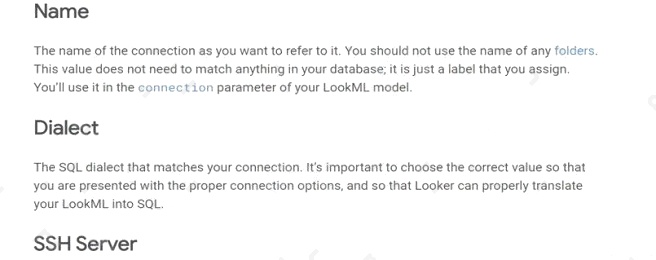
Question 10
The daily_forecast Explore used by the sales team needs to be cached for 24 hours. All other Explores used by the sales
team need to be cached for one hour.
What is a scalable way to configure this caching logic?
- A. Define two datagroups for the model. Apply persist_with at the model level with the datagroup for 1-hour caching, and apply persist_with to daily_forecast with the datagroup for 24-hour caching.
- B. Define max_cache_age on daily_forecast Explores of 24 hours. Define max_cache_age on all other Explores for one hour.
- C. Define two datagroups for the model. Create a persistent derived table (PDT) for the daily_forecast Explore, and apply datagroup_trigger to it using the datagroup for 24-hour caching.
- D. Define for the model one datagroup that caches for 1 hour. Create a persistent derived table (PDT) for the daily_forecast Explore, and apply sql_trigger_value to it selecting the current date.
Answer:
A
Explanation:
Reference: https://docs.looker.com/reference/explore-params/persist_for-for-explore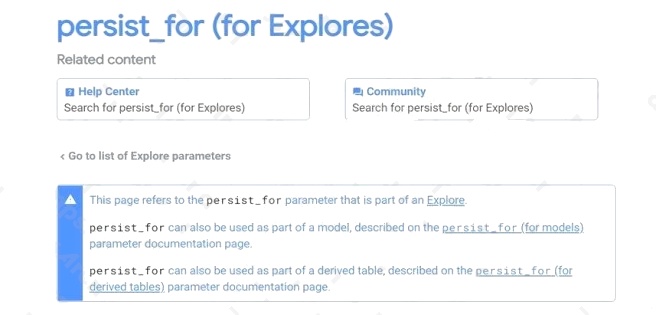
Question 11
A user reports an error message on an Explore: Non-unique value/primary key (or sql_distinct_key), value overflow or
collision when computing sum.
What should the LookML developer check for in the joined views of the Explore?
- A. The sum measure used is defined correctly.
- B. A unique primary key is defined in each view.
- C. Symmetric_aggregates: no is not present in the Explore definition.
- D. No concatenated primary keys are used.
Answer:
C
Question 12
A developer would like to add a new dimension of type: yesno for the enabled column in their users table. The column is of
type: string in the database and returns yes and no values.
How should the developer define the yesno dimension?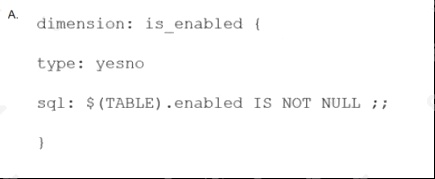
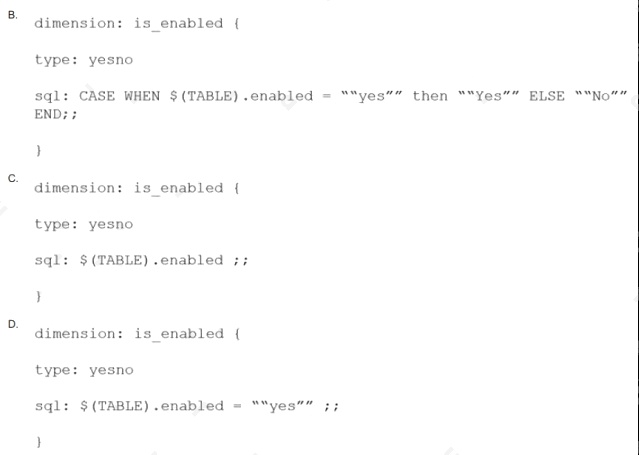
- A. Option A
- B. Option B
- C. Option C
- D. Option D
Answer:
A
Question 13
A developer has a persistent derived table view called user_facts that contains aggregated data for each user. The
developer needs to query the data from this table in another derived table view called user_region_facts.
Which strategy should the developer use to write the query for user_region_facts that will leverage the existing derived
table?
- A. Use ${user_facts.SQL_TABLE_NAME} to reference the user_facts derived table.
- B. Copy the name of the database table in the scratch schema for the user_facts derived table.
- C. Writhe the query form user_facts into a common table expression (WITH user_facts AS...).
- D. Write a subquery in the FROM clause and alias with ${user_facts}.
Answer:
C
Question 14
The code below shows a view order_items with its measures total_revenue and user_count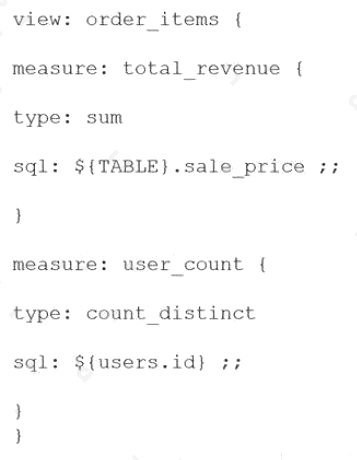
Which code correctly represents a new measure that calculates average revenue per user?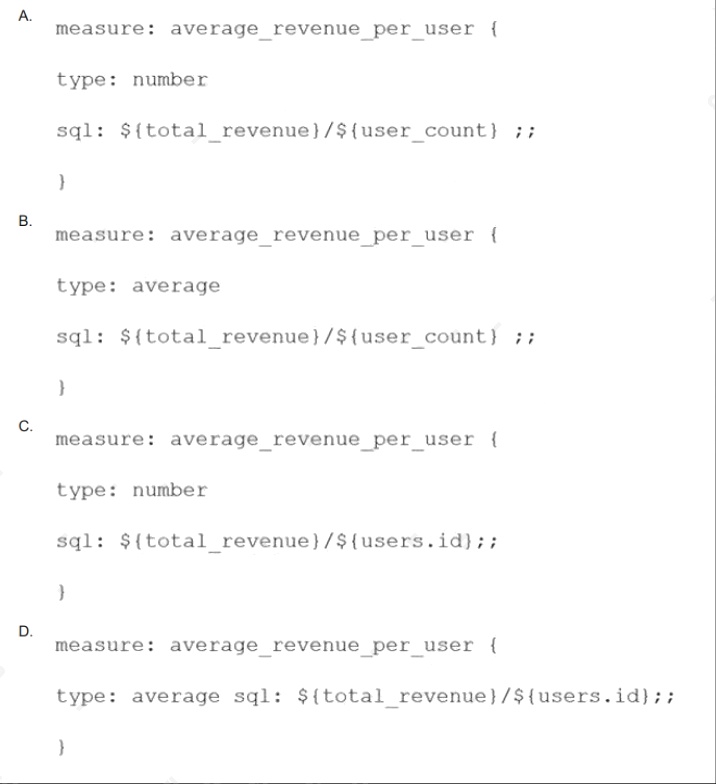
- A. Option A
- B. Option B
- C. Option C
- D. Option D
Answer:
C
Question 15
A developer has the dimensions enrollment_month and graduation_month already defined in the view. Both were created as
part of dimension_groups of type: time. The developer need to use these two dimensions in the sql_start and sql_end
parameters of a dimension group of type: duration.
Which LookML should be used to calculate the number of month and years between enrollment month and graduation
month?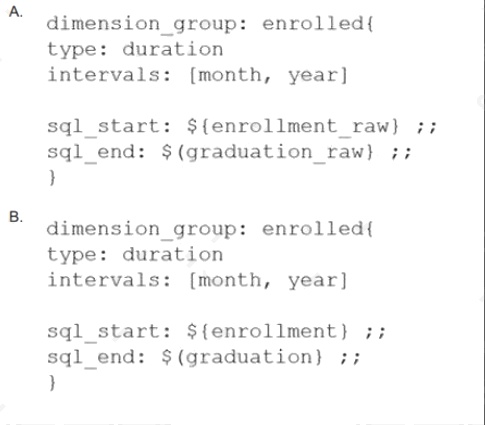
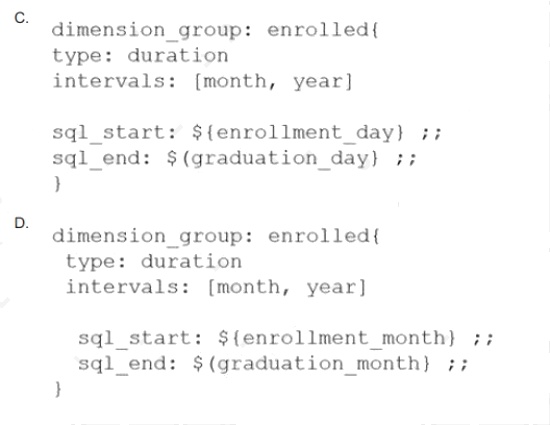
- A. Option A
- B. Option B
- C. Option C
- D. Option D
Answer:
A
Explanation:
Reference: https://docs.looker.com/reference/field-params/dimension_group